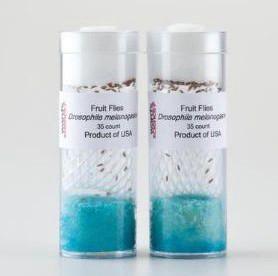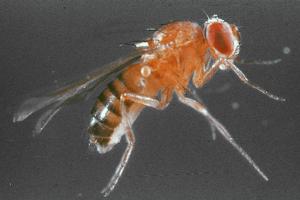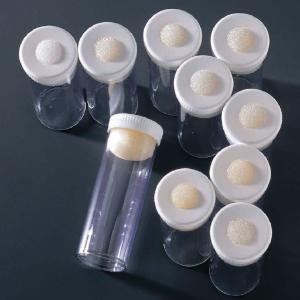How to teach with Drosophila: A free guide for working with and caring for your live materials.
Download this care guide for the facts on handling and making experimental crosses with this widely studied organism.
Introducing Ward’s How to Teach with Live Materials Series
Curious about teaching with live critters in your classroom, but not sure where to start? Or are you ready to incorporate a new type of specimen in your life science lessons but not sure which one is right for you? We’re here to help with our all-new How to Teach with Live Materials series of free guides. These free downloadable guides are packed with information and expert guidance from our in-house live materials lab technicians and biologists. You’ll get a thorough introduction to the wide world of living specimens and learn how to use them in your classroom to teach hands-on lessons that explore everything from life cycles, animal behavior, comparative anatomy, physiology, bio-chemical processes, disease, health, nutrition, and more!
Read on to learn about teaching with Drosophila and discover our other guides in this series at Ward’s World! Check back for more coming soon.
All Grades
How to Teach with Drosophila melanogaster
“Time flies like an arrow, but fruit flies like a banana,” Groucho Marx.
Ripen your students’ scientific knowledge with a lesson plan that includes the prodigious fruit fly. If we calculate it in fruit-fly years, there’s no time to waste (the life span of an adult fruit fly ranges between 7-50 days depending on environmental conditions).
The fruit fly's life cycle begins when the female lays her eggs on a long-forgotten piece of rotting fruit, vegetable, or other decaying, sweet organic material. After eggs hatch into tiny, white larvae, they munch on the rotting (yum!) food for about four days, absorbing the nutrients and energy they’ll need for the pupal stage.
The female fruit fly can lay a whopping 500 eggs. It only takes 24 hours for those eggs to hatch, and after only 48 hours, the females are ready to breed—no wonder getting rid of them out of the house is so hard!
Despite the havoc these pesky critters can cause in our households, Drosophila flies make the perfect organism to include in any biology lesson. Drosophila demonstrates several mutations, such as eye, wing, and body mutations. So, students can study sex-linked, recessive, and dominant mutations. The Drosophila also makes an excellent live food for mantises, small reptiles, and amphibians. Drosophila also demonstrates complete metamorphosis with egg, larva, pupa, and adult stages in its life cycle.
Consider the many reasons why these critters have become the world’s most ideal lab specimen:
- They are small and easily handled.
- They can be easily anesthetized and manipulated individually with unsophisticated equipment.1
- They are sexually dimorphic (males and females are different), making it easy to differentiate the sexes.
- Virgin fruit flies are physically distinctive from mature adults, making obtaining virgin males and females for genetic crosses easy.
- Flies have a short generation time (the average time between two consecutive generations 10-12 days) and do well at room temperature.
- The care and culture of fruit flies require little equipment, are low in cost, and use little space even for large cultures.
By using Drosophila, students can:
- Understand Mendelian genetics and inheritance of traits.
- Draw conclusions of heredity patterns.
- Gain an understanding of the life cycle of an insect that exhibits complete metamorphosis.
- Construct crosses of caught and known wild-type and mutated flies.
- Learn techniques to manipulate flies, sex them, and keep a concise lab notebook.
- Learn culturing techniques to keep the flies healthy.
- Conduct hands-on activities over several weeks.
Download the Working with Drosophila guide above to learn about handling and making experimental crosses with this fascinating organism.
About Ward’s Science Live Materials
Ward’s Science is committed to supplying high-quality specimens that support a wide variety of classroom activities and research. Because we cultivate and care for all of our live materials in our onsite labs, we ensure that your materials are always fresh, healthy, and delivered on time.
Discover our wide selection of live materials for teaching science here.
For more information about how to care for live materials, visit our Live Material Care Guide page; it has instructional and informational literature sheets for the most popular live specimens in our collection. From algae to vertebrates and everything in between, you will find the facts and instructions necessary to properly provide care for your live specimens and enrich your lessons with additional background information.
Our expert biologists and lab technicians are here to help with questions or one-on-one support with your live materials—Email sciencehelp@vwr.com for personalized support, custom orders, and more.
References: 1. The Berg Lab, University of Washington. An Introduction to Drosophila melanogaster
Recommended products
[StartProductBlock]

Live Drosophila melanogaster - Standard Crosses, Ward's Science
Demonstrate sex-linked, dominant, and recessive modes of inheritance. No pre-work needed - your crosses arrive already done.
[EndProductBlock]
[StartProductBlock]

Drosophila Sets, Live Fruit Flies
Cultures are shipped in with drosophila medium in a shatterproof vial.
[EndProductBlock]
[StartProductBlock]

Ward's® Drosophila Vial Set
Includes specially designed foam plugs that ensure adequate ventilation and prevent escape.
[EndProductBlock]
[StartProductBlock]
Etherizer
Specially designed unit to safely and easily etherize Drosophila or other living materials.
[EndProductBlock]
